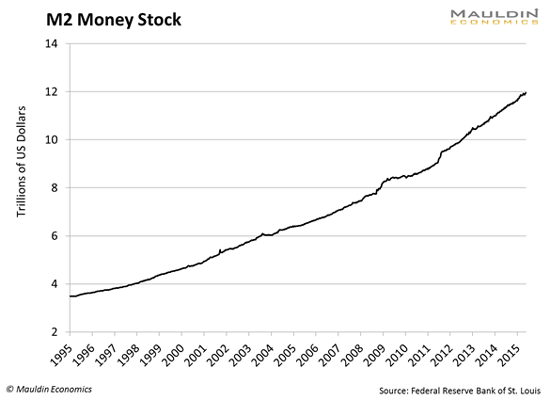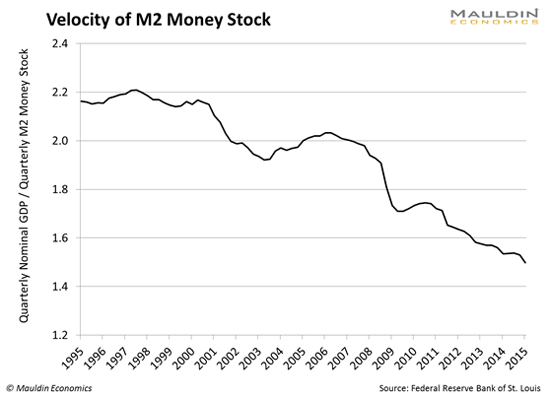Gold & Precious Metals
Sentiment Stinks… And That’s a Good Sign
Posted by Stefan Gleason of Money Metals Exchange
on Friday, 12 June 2015 14:19
 Markets typically bottom out when popular sentiment is negative. And a recent analysis by Bloomberg confirms that the public has all but given up on precious metals. Assets in exchange-traded products tied to metals prices fell to their lowest point since 2009.
Markets typically bottom out when popular sentiment is negative. And a recent analysis by Bloomberg confirms that the public has all but given up on precious metals. Assets in exchange-traded products tied to metals prices fell to their lowest point since 2009.
While holders of coins and other physical bullion products tend to hang tight during adverse market conditions, holders of derivate instruments are more likely to move in and out of the market – usually at the wrong times.
Sentiment could conceivably go from bad to worse. But history shows that opportunists who buy when times are tough ultimately rewarded with an opportunity to sell when times are euphoric.
Time for Presidential Aspirants to Take a Stand on Sound Money
 So, how many Republicans will announce a run for the White House this week?!
So, how many Republicans will announce a run for the White House this week?!
The most recent candidate to officially throw his hat into the crowded ring is Rick Perry, former governor of Texas. Perry had supported legislation to establish a Texas Bullion Depository in 2013. Just a few days ago, the Texas legislature finally approved a bill to that effect.
The Texas Bullion Depository will allow government agencies, private institutions, and individuals to hold gold with the backing of the state Comptroller’s Office.
Down the road, the first of its kind Bullion Depository could enable Texas to become more financially independent of the U.S. government and Federal Reserve System.
Monetary reform is an issue that could give Governor Perry traction. Though his shaky debate performances doomed his candidacy last time around, he is one of the few candidates who can viably run on a record of growing jobs.
In fact, without the 1.5 million job gains produced in Texas from 2008 through 2014, the U.S. would have suffered a net loss of 400,000 jobs.
The extent to which Governor Perry caused Texas’ private-sector hiring spree is debatable. What’s not debatable is that for the vast majority of Americans living outside Texas, the economy isn’t producing enough jobs.
 Official reports may show unemployment steadily declining nationwide, but the “unemployment rate” is such a sham statistic that not even Federal Reserve officials give it much credence in assessing the state of the jobs market. They know that the actual rate of workforce participation has barely budged from multi-decade lows recorded at the onset of President Obama’s second term.
Official reports may show unemployment steadily declining nationwide, but the “unemployment rate” is such a sham statistic that not even Federal Reserve officials give it much credence in assessing the state of the jobs market. They know that the actual rate of workforce participation has barely budged from multi-decade lows recorded at the onset of President Obama’s second term.
And privately, Fed officials must know that their policies are failing most Americans. The public by and large hasn’t participated in the Fed-fueled stock market advance.
Wall Street has been taken care of. The banks have been taken care of. The government has been taken care of. But Main Street still struggles.
Instead of getting a bailout, taxpayers are getting a massive bill. Thanks to the Fed’s trillion-dollar Quantitative Easing bond-buying campaign, Congress gets to borrow at artificially low rates.
The Fed-backed Congress feels no pressure to cut spending, and few members of Congress are willing to do so purely out of principle.
It’s politically easier just to saddle future taxpayers with unconscionable levels of debt.
When the debts become too large for taxpayers to service, the Fed gives Congress the ability to pull a stealth default through inflation. As Pippa Malmgen, former member of the President’s Working Group on Financial Markets, explained in an exclusive Money Metals podcast interview last week, “Inflation is a form of default. It’s a means by which a government ends up paying back less than they borrowed.”
That’s the road policymakers are taking us down.
It’s not our place here at Money Metals Exchange to endorse candidates for public office. However, we do view it as part of our mission to help educate the electorate about sound money. Toward that end, we hope the presidential candidates are asked – and asked until they give a straight answer – how they would rein in the Fed.
 Stefan Gleason is President of Money Metals Exchange, the national precious metals company named 2015 “Dealer of the Year” in the United States by an independent global ratings group. A graduate of the University of Florida, Gleason is a seasoned business leader, investor, political strategist, and grassroots activist. Gleason has frequently appeared on national television networks such as CNN, FoxNews, and CNBC, and his writings have appeared in hundreds of publications such as the Wall Street Journal, Detroit News, Washington Times, and National Review.
Stefan Gleason is President of Money Metals Exchange, the national precious metals company named 2015 “Dealer of the Year” in the United States by an independent global ratings group. A graduate of the University of Florida, Gleason is a seasoned business leader, investor, political strategist, and grassroots activist. Gleason has frequently appeared on national television networks such as CNN, FoxNews, and CNBC, and his writings have appeared in hundreds of publications such as the Wall Street Journal, Detroit News, Washington Times, and National Review.

“A gold mine is a hole in the ground with a bunch of liars standing next to it.”
I started investing in gold in 2005. Not a bad time, right?
Here’s why I started: I was the ETF trader at Lehman Brothers at the time. A couple of guys came by to talk about this crazy idea they had about a gold ETF. I think one was from the World Gold Council and the other was from State Street. The WGC guy brought along a 10-ounce bar of gold. At the time, it was worth almost $6,000.
The ETF was SPDR Gold Shares (GLD).(* Please see disclosure below)
I ended up buying GLD, because I’m a trader. Trading stocks is what I do, so it’s easy for me to buy something with a ticker. I didn’t even know you could buy physical gold. It was 2005 or 2006, so I’m not even sure if the online bullion dealers were up and running yet. If you wanted to buy gold, you’d have to be in the know, go to some hole-in-the-wall coin dealer, get your face ripped off.
I have owned GLD since. And along the way, I learned a lot about investing in physical gold, and I bought that, too.
But that’s not the interesting part.
I Loathe Gold Culture
One of the things I figured out as I was starting to invest in precious metals is that a lot of the other guys investing in gold and silver were… not the kind of guys I really wanted to hang out with. Neckbeard McGoldbug. You know the type.
I’m talking about the ridiculous conspiracy theories, the bizarre politics that are so far right, they’re left. The hatred toward banks. I still don’t understand it. These are supposedly right-wing guys who found themselves on the same side of most issues as Matt Taibbi and Elizabeth Warren. The apocalyptic outlook, the relentlessly bearish views, the outright refusal to participate in one of the biggest (and most obvious) stock market rallies ever.
I am allegedly a right-wing guy—and I’ll own it—but I am not that.
The other thing I discovered about these guys is that it’s useless to try to sell newsletters to them. They don’t believe in intellectual property.
So part of my gold investing career has been figuring out what I am and what I’m not. I guess you could call me a classical liberal and monetarist who takes a keen interest in gold.
Freeze It, Personalize It, Polarize It
As the gold rally crested and rolled over, the mainstream financial media really started to go after the gold bugs. They were super annoying on the way up, and the (mostly liberal, Keynesian) pundits were crushing them on the way down. It’s gotten to the point where the only people left buying gold are… Neckbeard McGoldbug, and they’ve been thoroughly maligned for it.
If you recall, the whole idea was that quantitative easing (printing money) was going to create a lot of inflation. Plus, the budget deficit was about $1.8 trillion at the time, so we would have to monetize the debt. It was a pretty good argument. And it worked for years.
Then it stopped working.
The inflation the gold bugs predicted never happened. It was the biggest hoax perpetuated on investors, ever. So the beatdown from the Keynesians continues to this day, on Twitter, on blogs, in the news.
But maybe the gold bugs weren’t wrong—just super early.
I’m Not an Economist, But…
I do remember this from a class I had: the quantity theory of money.
MV = PQ
I’m sure this looks familiar to many of you.
So M, the supply of money, has gone way up:

But V, money velocity, has gone way down:

Given constant Q (quantity of goods), P (price) remains pretty much unchanged.
So we will eventually get our inflation—if money velocity turns around and heads higher.
There aren’t any good theories as to why money velocity continues to plummet. At least, I haven’t read any. I think we will have a similar inability to predict when it rises.
This is overly simplistic, but I’m a simple guy.
Gold Is/Is Not for the Long Run
There are people who say gold should be x percent of your portfolio in all weather. I get it. It tends to be negatively correlated with other stuff, so it reduces the volatility of a portfolio.
And as long as central banks are doing what they’re doing, the long-term case for gold is pretty much intact, recent price action notwithstanding.
But let me tell you this. If central banks ever got religion and pulled a Volcker and hiked rates to the moon, it would be a remarkably bad time to hold gold.
On the other hand, throughout history, there have been times where people were very sad that they didn’t own gold. I talk about one of them here.
It’s very real, and the history of fiat currencies is also quite sad.
I am the furthest thing from an alarmist. I don’t think the dollar, or the euro, or any other currency is going to collapse, at least not imminently.
But I also think the Fed doesn’t want to raise interest rates, possibly ever.
The ECB is printing, and you have the prospect of direct monetization.
Japan is just insane.
Even Sweden is printing money.
And I can see a scenario where Canada, Australia, and Norway are all doing it too.
So: if the whole world is printing money, I’m okay with being long gold.
But in 2015, you really shouldn’t care about what people think.
*Disclosure: at the time of this writing, Jared Dillian was long GLD, SLV, and physical gold and silver.

Jared Dillian
Editor, The 10th Man![]()
Jared’s premium investment service, Bull’s Eye Investor, is available now. Click here for our introductory offer. For Jared, no asset class or type of investment is off limits. From an iconic sports outfitter to a particularly liquid frontier-market ETF—Jared picks the best vehicles for his subscribers to profit from tomorrow’s trends today. Put Jared’s ingenious mix of market analysis and trader’s intuition to work in your portfolio today. Follow Jared on Twitter at @dailydirtnap.

Clive Maund – Gold Market Update
Posted by Clive P. Maund
on Wednesday, 10 June 2015 13:27
Although the longer-term bullish case for gold could scarcely be stronger, over the short to medium-term the picture continues weak, with it looking vulnerable to breaking down into another downleg to the $1000 area and perhaps lower. In the last update you may recall that there was some optimism expressed that it might perk up on the dollar topping out, but such has not proved to be the case – instead it has performed miserably and now looks set to drop more steeply to new lows.
On its 8-year chart we can see that gold remains in the grip of the bearmarket in force from its bullmarket highs of 2011. 

Precious Metals Short Term Bearish View
Posted by Biiwii.com & NFTRH.com
on Monday, 8 June 2015 12:50
Last week we reviewed the gold sector from a big picture perspective. The view was one of an incomplete process that should lead to the next big trend trade beginning on a horizon of multiple months on the short end, up to 1-2 years on the longer end. This week, we excerpt NFTRH 346’s fairly brief Precious Metals segment, which shows a more bearish short-term view.
Precious Metals
From NFTRH 345 with respect to this chart: “If at any time you see gold drift below 1180, please consider having extreme caution if you are a ‘price’ player. If you are a long-term holder like me… as you were, sleep well.”

I am going assume that price players are doing what they need to do in the event this situation worsens.
As we have noted all through the bear market, speculators should not care about whether or not they miss the earliest parts of any new bull market. That is because the next cyclical bull market will be an extended and profitable affair. But in the here and now, there is risk.
Silver lost the short-term trend line noted last week and is now below the 50 day averages as well as the SMA 200. This is non-actionable at best.

HUI has dropped to the key 160 support parameter. That is lateral support as well as ‘higher lows’ (to November, December & March) support. It had better hold or else.

Junior Miners ETF GDXJ dropped out of the uptrend channel noted last week and the exploration ETF (GLDX) continued downward after losing its channel.


Finally, the perspective chart on the Gold Miners (GDM) vs. S&P 500. The time to favor the miners is coming. But if past is a prologue, it could still be up to a year or more before the ratio bottoms. A safe signal would be a moving average trigger as in 2001.

The best investment situation in the gold sector is going to be when gold bottoms vs. stock markets, out performs commodities and comes back into favor amidst a risk ‘OFF’ environment. Don’t let them tell you that strong jobs = inflation = a panic for gold. That is promotion. Risk is still ‘ON’ in the financial markets, so gold is still ‘OFF’.
<end excerpt>
The above is just a small portion of NFTRH 346’s 33 pages, which included additional discussion and context on the precious metals, as well as a comprehensive overview of the the economic backdrop, interest rates (the key to most other markets), US and global stock markets and discussion about individual stocks and favored sectors.
I firmly believe that the gold sector should be kept in view as the next big trend trade, but not obsessed upon (to the exclusion of so many other long and short opportunities across several other asset classes) in the interim.
For consistent, high quality analysis (weekly report and in-week updates on markets and individual equities) that keeps subscribers on the right side of markets, consider an affordable premium subscription to NFTRH.

Who’s Next? China Finally Starts Snapping Up Gold Miners
Posted by John Rubino - DollarCollapse.com
on Saturday, 6 June 2015 21:25
One (perhaps the only) bright spot in the past few years’ gold market has been Chinese and Indian demand for the metal. Here’s a chart, courtesy of Ed Steer’s Gold & Silver Daily, showing that the two countries have imported a cumulative 15,000 tonnes since 2008, which is not far from the total production of the world’s gold mines in that period.

But physical bullion is only part of the story, and may not be the biggest one going…..continue reading HERE


-
I know Mike is a very solid investor and respect his opinions very much. So if he says pay attention to this or that - I will.
~ Dale G.
-
I've started managing my own investments so view Michael's site as a one-stop shop from which to get information and perspectives.
~ Dave E.
-
Michael offers easy reading, honest, common sense information that anyone can use in a practical manner.
~ der_al.
-
A sane voice in a scrambled investment world.
~ Ed R.
Inside Edge Pro Contributors

Greg Weldon

Josef Schachter

Tyler Bollhorn

Ryan Irvine

Paul Beattie

Martin Straith

Patrick Ceresna

Mark Leibovit

James Thorne

Victor Adair
